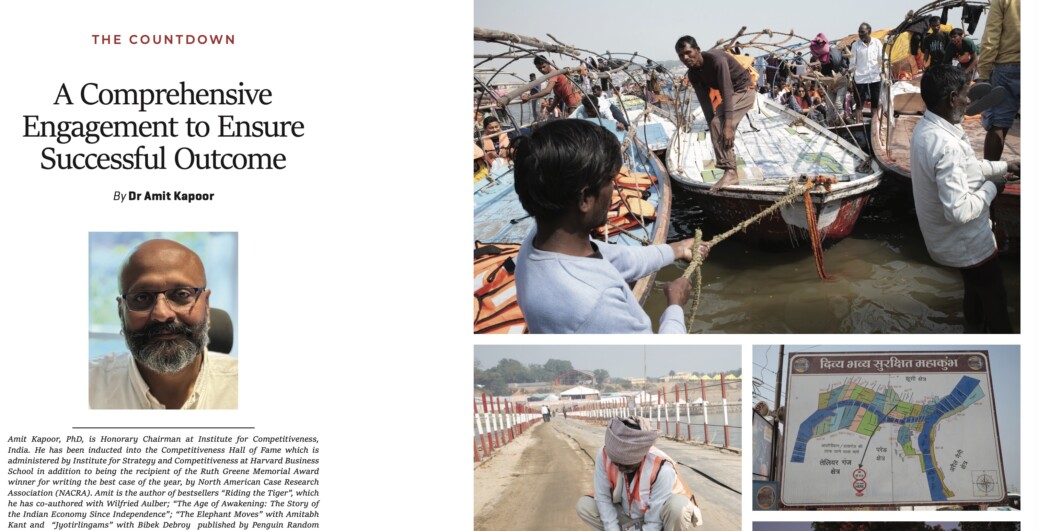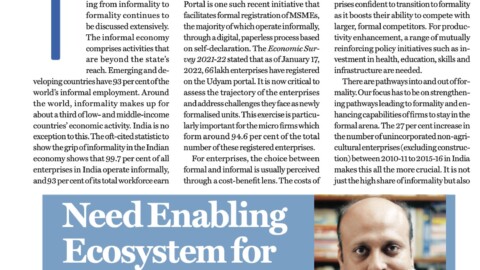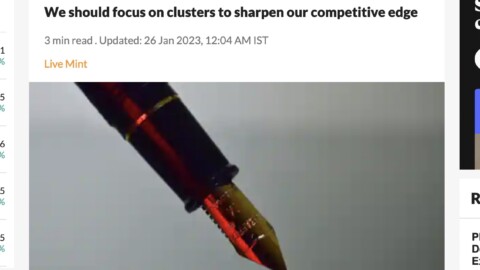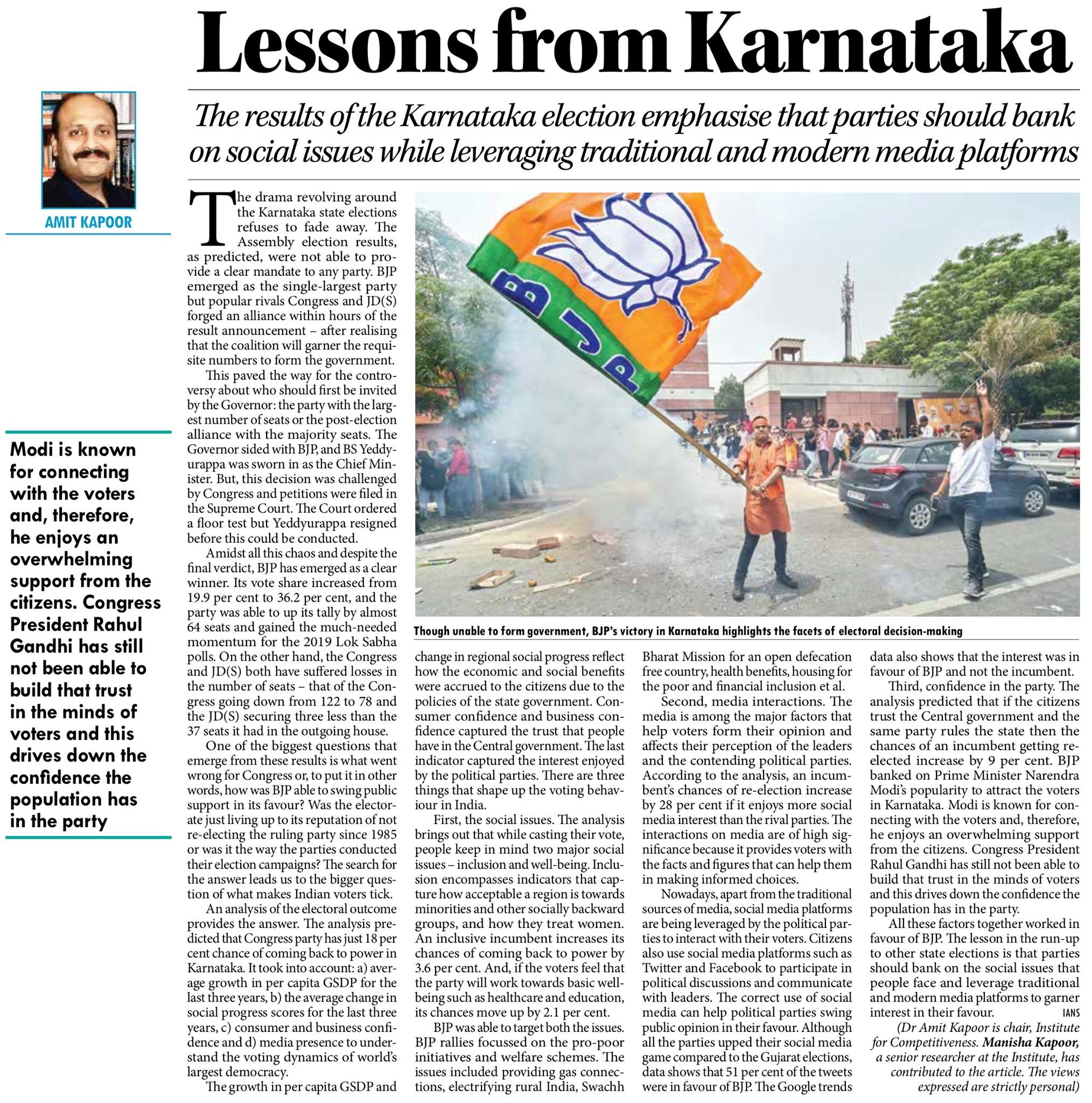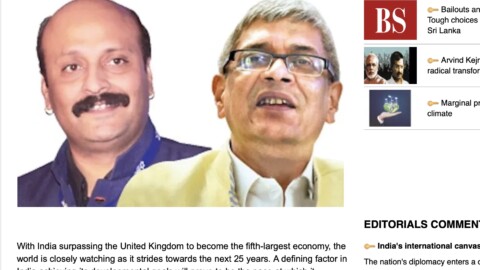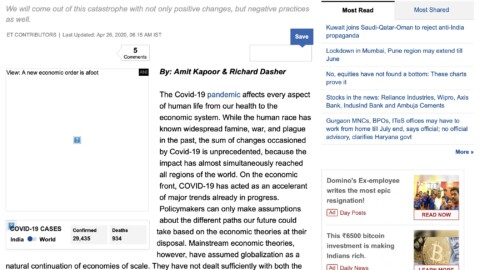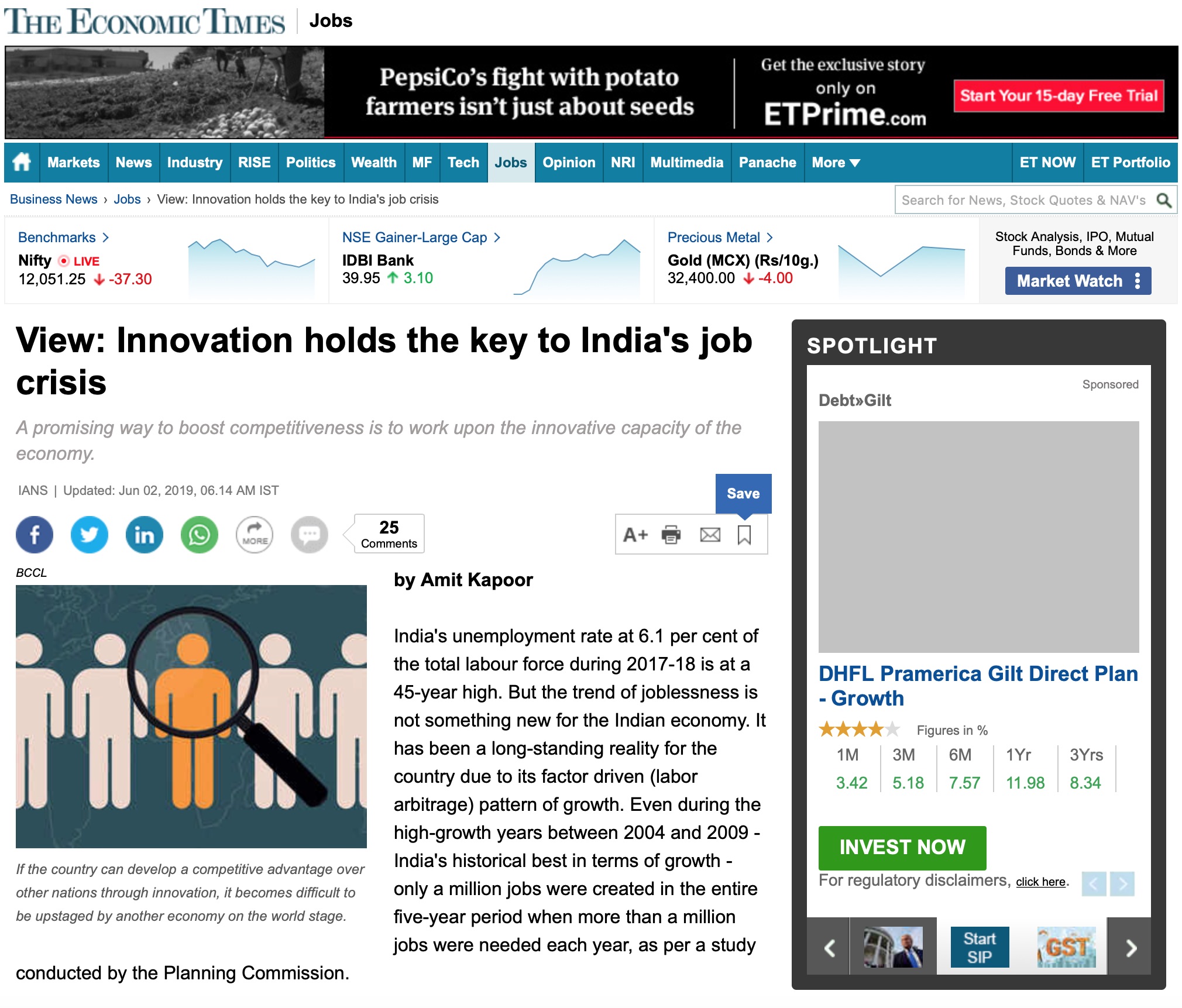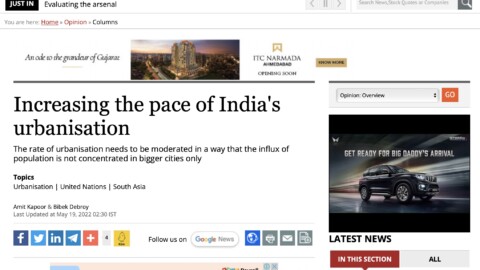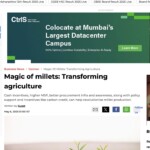By Amit Kapoor
The Maha Kumbh Mela 2025, which over 470 million people have already visited, is a world unto itself. The sheer magnitude of the human gathering to visit the sacred Triveni Sangam in Prayagraj has been monumental. It has surpassed that of the United States and many other countries worldwide, making it the world’s largest human gathering of 45 days, which continues to unfold and will reach its conclusion on Maha Shivaratri, February 26th 2025.
It is important to understand the uniqueness of this religious gathering to understand how this mela has been a marvel and needs to be managed in every sense. The Kumbh Mela is held every 12 years. Its date is determined by the astrological positions of Jupiter, the Sun, and the Moon.
In Mela, millions of visitors from various parts of India and around the world travel to the Prayagraj district, which has a population of 1.4 million, to take a dip at the Triveni Sangam. The Triveni Sangam is the country’s only confluence of the holy rivers Ganges, the Yamuna, and the mythical Saraswati. It is the most sought destination in Hinduism, drawing its significance from thousands of years as pilgrims come to this sacred site to cleanse their sins, rid themselves of past karmas, and seek moksha. Taking a bath symbolizes spiritual purification, liberation, and renewal. It washes away sins and paves the way for moksha, which is liberation from the cycle of birth and death.
The biggest challenge of organizing such a gathering is navigating the ebb and flow of millions to the Triveni Sangam during the Mela. Unlike other mass religious gatherings, it is not about reaching a destination but about walking, living, and moving across the very riverbed itself. Specific celestial alignments also dictate the flow of people taking a dip around Triveni Sangam during auspicious days, such as “Mauni Amavasya.” On these occasions, people from all walks of life including akharas, sadhus, and crowds from all over the country- come to take a dip at Triveni Sangam. So, the crowd often swells within a few hours at the Sangam Nose, often creating a bottleneck.
This is where this logistical marvel in the form of a temporary city comes to life. Spanning 4000 hectares near the Sangam, the Maha Kumbh Mela has created the world’s largest temporary city. The sheer number of populations, particularly during the shahi snan days, creates various challenges to crowd management, transportation, safety, and emergency response. Therefore, the management of Kumbh is meticulously designed to ensure adequate infrastructure, security, and services to meet the needs of a vast influx of pilgrims and ensure effective management of the entire event.
Crowd management is one of the most pressing concerns when managing an event of this magnitude. Security at the Mela involves not only law enforcement but also readiness of robust physical and digital infrastructure to ensure smooth and efficient crowd movement. One logistical challenge faced during the development of the mela infrastructure was the timely construction of pontoon bridges, also known as “Peepa Puls.” Initially hindered by the high-water flow of the Ganges, which reached 20,000 cusecs in October 2024, well above the ideal range of 6,000 to 10,000 cusecs for construction, the government faced significant logistical challenges. The number of these floating pontoon bridges has also been increased from 22 to 30, facilitating controlled pathways for goods, VIPs, Akhadas, and crowds entering the mela. Construction of these vital structures began in November, and within less than 60 days, the Peepa Puls were operational, ensuring safe and efficient movement for people throughout the Mela. Special teams are on standby every day to make adjustments and repairs as necessary, ensuring the floating infrastructure functions seamlessly during the event.
The Spread of Peepa Puls are strategically located across four sectors near the Sangam Nose, connecting essential locations such as Daraganj, Jhusi, interstate depots, railway stations, and parking areas. Managing the flow of pilgrims during the Shahi Snaan, the most significant bathing ritual, is particularly challenging. The design of the Peepa Puls, numbered from 1 to 8, is specifically intended to prevent assemblage in any one area. This system facilitates a circular flow of people, ensuring that no bottlenecks occur at any entry point. The aim is to create a smooth environment where people continuously move toward the Sangam, thereby avoiding crowding.
The expansion of the Sangam bathing area was another significant logistical undertaking. The irrigation department, in collaboration with the Mela administration, mobilized 250 dredgers and over 16,000 labourers to reclaim more than 2 hectares of land at the Triveni Sangam in just 85 days. This governmental initiative has greatly increased the capacity to accommodate millions of people. Understanding the spiritual importance of the Sangam Snan, the government has made extensive efforts to enhance capacity and ensure a smooth experience for pilgrims. This expansion now allows at least 200,000 more devotees to bathe simultaneously, marking a considerable increase compared to past years. Additionally, the deployment of four dredging machines has resulted in the reclamation of an extra 26 hectares of land, effectively tripling the bathing capacity at the Sangam compared to 2019. This remarkable feat of land reclamation was achieved through careful planning and the concerted efforts of the irrigation department, labourers, and technical teams. The extension of the Sangam bathing area ensures that the Maha Kumbh Mela can accommodate the significant influx of devotees, providing them with a safe and spiritually fulfilling experience. Along with this, the rejuvenation of several historic ghats with an investment of ₹15 crores, such as the Old Arail, Baluwa, Kali, and Mauzgiri ghats along the Yamuna River and the Chhatanag, Nageshwar, and Rasulabad ghats along the Ganga River demonstrates a commitment to both spiritual and infrastructural enhancement. These ghats have been enhanced and improved for better access and experience, allowing devotees to participate in rituals without any obstacles.
The UP government allocated a total budget of over 7000 crores, with 42.18% earmarked for Bridges and Road Development. These play a crucial role in building robust infrastructure to ensure the smooth flow of people. However, the protection of human life and effective crowd management are essential public services provided by the government to ensure the successful administration of the Kumbh Mela. A significant deployment of police and armed forces plays a crucial role in maintaining security during the event. To supplement the existing police force in Prayagraj, additional personnel are drawn from all 75 districts of Uttar Pradesh. Additionally, companies of armed forces stationed across India are mobilized to support security operations at the Kumbh Mela. Their collective experience in handling diverse situations ensures a swift and effective response to any unforeseen incidents during the event. The civil police primarily oversee traffic management and overall security within the Mela premises. The armed forces, however, operate under a distinct mandate. For instance, the Rapid Action Force (RAF) specializes in riot control and civil unrest, with specific drills designed to handle various disturbances. Similarly, forces like the Indo-Tibetan Border Police (ITBP) bring expertise in managing violent situations. Nevertheless, unless an extreme situation arises, the armed forces collaborate with the civil police to facilitate the smooth day-to-day functioning of the Kumbh Mela. While all security forces share the common objective of ensuring a safe and orderly event, their roles and operational approaches differ significantly based on their specialized training. Under the direction of the Mela Administration, each force is assigned specific responsibilities tailored to the unique challenges posed by one of the largest gatherings of people on Earth.
The security of the Kumbh Mela is further reinforced through an extensive network of technology and digital solutions. Approximately 2,700 CCTV cameras, including 328 AI-enabled cameras, have been installed to enhance surveillance and ensure the safety of attendees. These systems play a crucial role in deterring criminal activities and facilitating the smooth movement of the crowd. Additionally, the technology enables law enforcement authorities to monitor population density in real-time, allowing them to identify high-risk areas or emerging congestion hotspots. This real-time data is instrumental in preventing incidents such as stampedes and ensuring a safe and well-regulated environment for all visitors.
The unfortunate stampede incident that occurred on January 29 has drawn significant attention, with numerous reports and media coverage detailing the stampede and its impact on attendees. While the administration had planned for such contingencies, it is important to recognize that these are high-intensity events. The Shahi Snaan of Mauni Amavasya which fell on 29th January this time, is the most significant bathing day of the Kumbh Mela.
Following the January 29 stampede, authorities implemented several measures to prevent similar incidents. For instance, on February 12, designated as a key bathing day, the entire area Kumbh Mela grounds were declared a no-vehicle zone. Additionally, VIP passes for the Baisakhi Panchami Snan on 3rd February were initially cancelled and later reissued with stricter limits to regulate the number of vehicles entering the Kumbh Mela grounds. The administration has also actively worked to reduce population density in critical areas, although no official figures have been released regarding the revised thresholds. Moreover, there has been a notable increase in patrolling efforts by the police and armed forces across the Mela grounds. Regular and frequent announcements about roads and bridges which are operable and the different ghats available for Snaan can be heard clearly across the Mela grounds in various Indian languages. Authorities have been relocating individuals resting or sleeping in high-density zones, particularly at key intersections, near ghats, and other congestion-prone areas.
At this stage, the efforts of the Lost and Found Centers also deserve recognition. While official statistics have not been disclosed, our on-ground investigations suggest that each center is successfully handling over 30 plus reports per day. These centers operate with high efficiency, working in coordination with law enforcement and volunteer organizations to reunite lost individuals with their families. Additionally, they ensure that those who arrive at the centers have access to food, water, and medical assistance. A key enabler of this process is the real-time centralized database used by the Lost and Found Centers. The system continuously updates, allowing for swift cross-referencing between reports of missing individuals and their family members’ inquiries across different sectors. The speed of this process is remarkable, and the relief and gratitude expressed by reunited families underscore the effectiveness of these measures.
Water management is second important crucial for the Maha Kumbh Mela management, especially considering the large number of pilgrims attending the event. Providing access to clean water is essential for their well-being. The Uttar Pradesh government has prioritized water and sanitation infrastructure for the Kumbh Mela, allocating over ₹1,600 crore (22% of the total budget) to more than 62 related projects. As part of these efforts, 233 reverse osmosis (RO) water ATMs have been installed across all sectors, particularly at key intersections, providing free and easily accessible purified drinking water to pilgrims. Additionally, over 65,000 potable water taps and 85 tubewells have been strategically placed throughout the venue. These installations are supported by a 650 km pipeline network and a 200 km drainage system, ensuring efficient water distribution and waste management. This comprehensive system is essential for maintaining public health and preventing waterborne diseases in such a massive gathering.
A coming together of such a vast magnitude as Kumbh inevitably generates an immense volume of waste every day and every hour. Thus, sanitation becomes, third and more than any other aspect, a defining feature of the Maha Kumbh Mela’s success. The authorities have put in place a robust sanitation infrastructure to cater to the massive number of pilgrims. With over 1,50,000 temporary toilets and more than 500 permanent toilets spread across the grounds, the Mela has made cleanliness a top priority. To ensure proper sanitation during the Kumbh Mela, the government installed 12,000 Fiber Reinforced Plastic (FRP) toilets with septic tanks, 16,100 prefabricated steel toilets connected to soak pits, and 20,000 strategically placed community urinals throughout the Mela grounds.
In addition, the authorities have ensured the construction of sewage treatment plants (STPs) to manage the waste generated by these facilities and to process the waste efficiently and keep the area clean and hygienic. In 2019, efforts to manage wastewater were limited to oxidation ponds, which were used to ensure that grey water was clean enough before being discharged into the river. However, for the 2025 Kumbh Mela, significant advancements have been made. In addition to the permanent Sewage Treatment Plants (STPs) already operational in Prayagraj, three temporary STPs have been constructed with support from BARC and ISRO. Additionally, Faecal Sludge Treatment Plants (FSTPs) are also in operation designed to treat wastewater generated on-site during the Mela. To monitor and maintain the quality standards, several key water quality parameters are regularly assessed, including Biochemical Oxygen Demand (BOD), Chemical Oxygen Demand (COD), Total Suspended Solids (TSS), and pH levels.
Taken together, sanitation infrastructure is designed to ensure that every pilgrim has access to clean, safe, and accessible restroom facilities, minimizing the risks associated with poor sanitation and ensure that the Mela is Open Defecation Free (ODF) zone. Additionally, machines have deployed across various ghats so that pooja waste floating in the rivers is taken out promptly. The Maha Kumbh Mela further offers comprehensive health services, including 6,000 beds, 43 hospitals, and lances for the comfort of pilgrims. The Ayush team, with 80 doctors across 20 OPDs, ensures 24×7 medical support, catering to a wide range of health needs, including consultations for foreign devotees. The implementation of this entire system is essential not only for the health of the pilgrims but also for maintaining the sanctity and cleanliness of the Mela area, which is itself a sacred space.
The extensive infrastructure, resource mobilization, and meticulous planning ensure that the Kumbh Mela—the largest congregation on Earth—runs smoothly. It is essentially a melting pot where the diverse colours of India come alive, reflected in the vibrant marketplace that brings together shopkeepers and street vendors from across the country. From Faridabad’s toys and Jabalpur’s chaat to Banaras’ sarees and Udaipur’s handicrafts, the Mela becomes a dynamic showcase of India’s rich craftsmanship and regional specialties. Pilgrims can find herbal tea, ointments, and massage oils from Ranchi; pooja and havan materials from Haridwar; sandalwood and perfumes from Chennai; and holy pendants from Nashik. Everyday essentials, including groceries, are sourced from nearby areas of Prayagraj, ensuring that visitors experience both convenience and cultural richness.
The Kumbh Mela stands apart with its unique characteristics, presenting immense complexities and challenges that are tackled through the coordinated efforts of various government functionaries. On one hand it is spiritual, religious and offers a deeply personal experience, on the other, it is an event for expansive management and economic of a scale never seen before. It is also a testament to India’s capability to orchestrate a global-scale event with efficiency, resilience, and a focus on public welfare. The successful execution of the Maha Kumbh Mela 2025 will reflect an extraordinary confluence of strategic planning, infrastructural development, and technological innovation and has the potential of serving as a blueprint for aspirational blocks, smart cities and districts on a national and international level.
Dr Amit Kapoor contributed an article in the special edition of “Conversation Magazine” titled “Destination India:Tourism Exchange” edition February 15, 2025.
